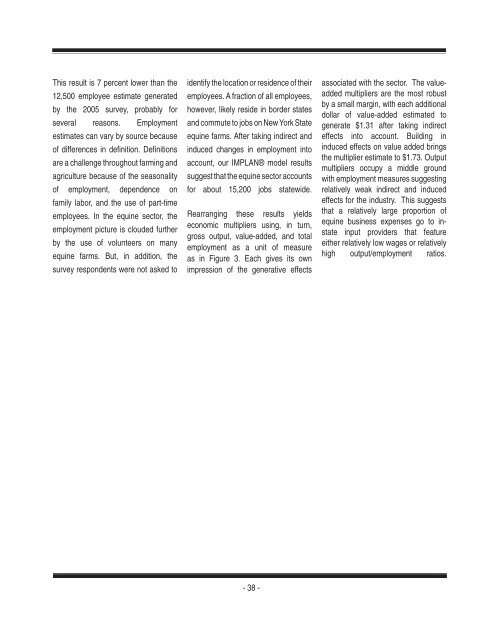Retired Racehorses
tfrr_reportandappendicesfinal
tfrr_reportandappendicesfinal
- No tags were found...
You also want an ePaper? Increase the reach of your titles
YUMPU automatically turns print PDFs into web optimized ePapers that Google loves.
This result is 7 percent lower than the<br />
12,500 employee estimate generated<br />
by the 2005 survey, probably for<br />
several reasons. Employment<br />
estimates can vary by source because<br />
of differences in definition. Definitions<br />
are a challenge throughout farming and<br />
agriculture because of the seasonality<br />
of employment, dependence on<br />
family labor, and the use of part-time<br />
employees. In the equine sector, the<br />
employment picture is clouded further<br />
by the use of volunteers on many<br />
equine farms. But, in addition, the<br />
survey respondents were not asked to<br />
identify the location or residence of their<br />
employees. A fraction of all employees,<br />
however, likely reside in border states<br />
and commute to jobs on New York State<br />
equine farms. After taking indirect and<br />
induced changes in employment into<br />
account, our IMPLAN® model results<br />
suggest that the equine sector accounts<br />
for about 15,200 jobs statewide.<br />
Rearranging these results yields<br />
economic multipliers using, in turn,<br />
gross output, value-added, and total<br />
employment as a unit of measure<br />
as in Figure 3. Each gives its own<br />
impression of the generative effects<br />
associated with the sector. The valueadded<br />
multipliers are the most robust<br />
by a small margin, with each additional<br />
dollar of value-added estimated to<br />
generate $1.31 after taking indirect<br />
effects into account. Building in<br />
induced effects on value added brings<br />
the multiplier estimate to $1.73. Output<br />
multipliers occupy a middle ground<br />
with employment measures suggesting<br />
relatively weak indirect and induced<br />
effects for the industry. This suggests<br />
that a relatively large proportion of<br />
equine business expenses go to instate<br />
input providers that feature<br />
either relatively low wages or relatively<br />
high output/employment ratios.<br />
- 38 -


